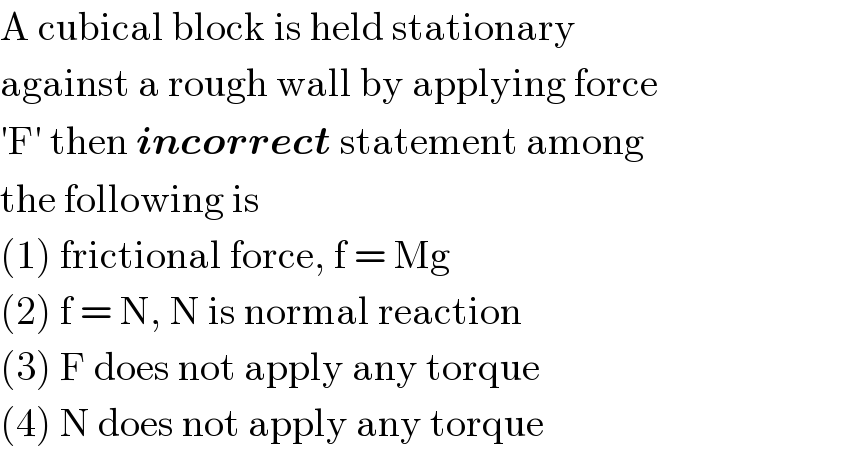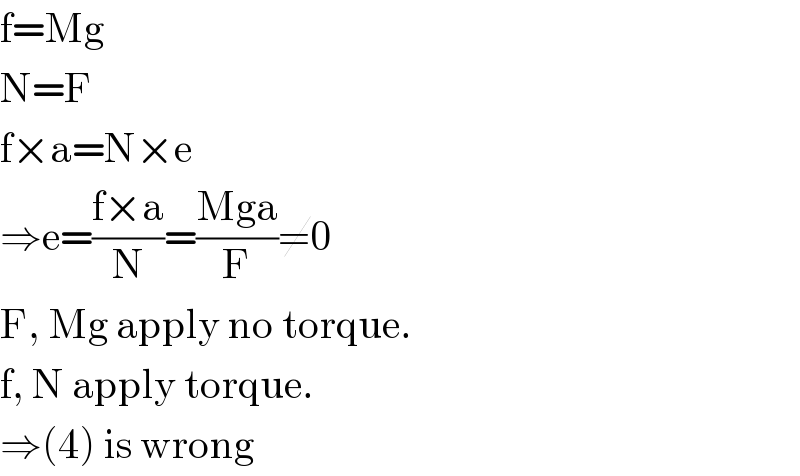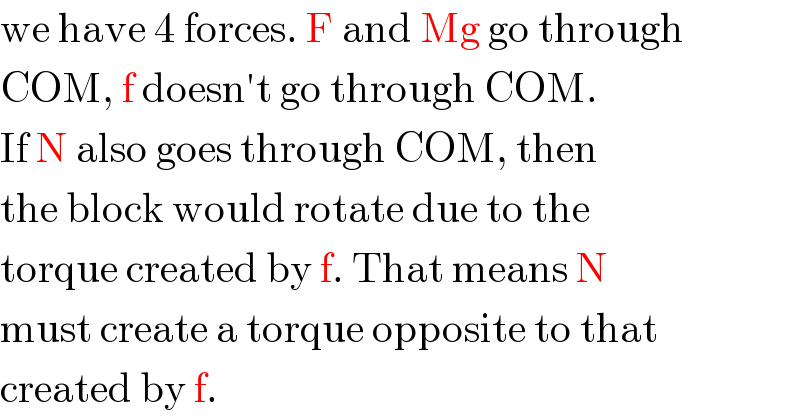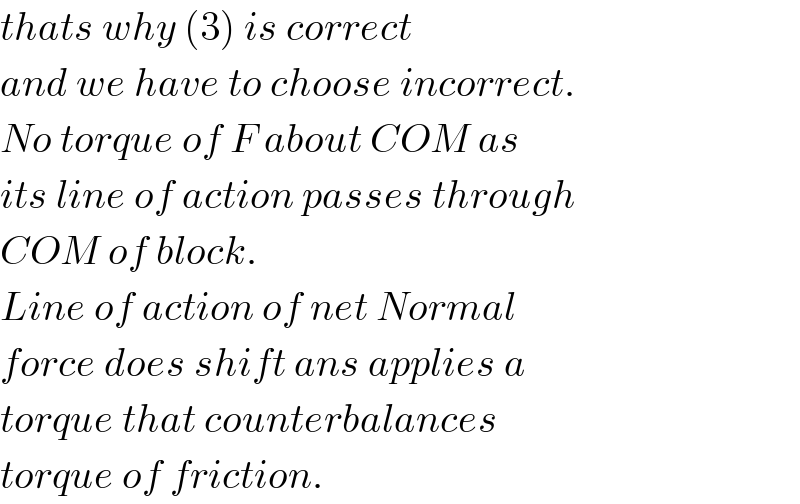
Question Number 22437 by Tinkutara last updated on 18/Oct/17

$$\mathrm{A}\:\mathrm{cubical}\:\mathrm{block}\:\mathrm{is}\:\mathrm{held}\:\mathrm{stationary} \\ $$$$\mathrm{against}\:\mathrm{a}\:\mathrm{rough}\:\mathrm{wall}\:\mathrm{by}\:\mathrm{applying}\:\mathrm{force} \\ $$$$'\mathrm{F}'\:\mathrm{then}\:\boldsymbol{{incorrect}}\:\mathrm{statement}\:\mathrm{among} \\ $$$$\mathrm{the}\:\mathrm{following}\:\mathrm{is} \\ $$$$\left(\mathrm{1}\right)\:\mathrm{frictional}\:\mathrm{force},\:\mathrm{f}\:=\:\mathrm{Mg} \\ $$$$\left(\mathrm{2}\right)\:\mathrm{f}\:=\:\mathrm{N},\:\mathrm{N}\:\mathrm{is}\:\mathrm{normal}\:\mathrm{reaction} \\ $$$$\left(\mathrm{3}\right)\:\mathrm{F}\:\mathrm{does}\:\mathrm{not}\:\mathrm{apply}\:\mathrm{any}\:\mathrm{torque} \\ $$$$\left(\mathrm{4}\right)\:\mathrm{N}\:\mathrm{does}\:\mathrm{not}\:\mathrm{apply}\:\mathrm{any}\:\mathrm{torque} \\ $$
Commented by Tinkutara last updated on 18/Oct/17

Commented by math solver last updated on 18/Oct/17

$${i}\:{think}\:{statement}\:\mathrm{2}\:{is}\:{wrong}\:{i}.{e}\:{f}\:=\:{N}. \\ $$
Commented by Tinkutara last updated on 18/Oct/17

$$\mathrm{No}.\:\mathrm{Wrong}\:\mathrm{answer}. \\ $$
Commented by ajfour last updated on 18/Oct/17

$${only}\:{statement}\:\left(\mathrm{4}\right)\:{is}\:{incorrect}. \\ $$$$\left(\mathrm{2}\right)\:{might}\:{be}\:{correct}\:{depending} \\ $$$${on}\:{value}\:{of}\:\mu\:. \\ $$
Commented by Tinkutara last updated on 18/Oct/17

$$\left(\mathrm{3}\right)\:\mathrm{should}\:\mathrm{be}\:\mathrm{wrong}\:\mathrm{since}\:\mathrm{line}\:\mathrm{of}\:\mathrm{action} \\ $$$$\mathrm{of}\:\mathrm{F}\:\mathrm{passes}\:\mathrm{through}\:\mathrm{COM}\:\mathrm{of}\:\mathrm{block}.\:\mathrm{Why} \\ $$$$\mathrm{not}? \\ $$
Commented by mrW1 last updated on 18/Oct/17

Commented by mrW1 last updated on 18/Oct/17

$$\mathrm{f}=\mathrm{Mg} \\ $$$$\mathrm{N}=\mathrm{F} \\ $$$$\mathrm{f}×\mathrm{a}=\mathrm{N}×\mathrm{e} \\ $$$$\Rightarrow\mathrm{e}=\frac{\mathrm{f}×\mathrm{a}}{\mathrm{N}}=\frac{\mathrm{Mga}}{\mathrm{F}}\neq\mathrm{0} \\ $$$$\mathrm{F},\:\mathrm{Mg}\:\mathrm{apply}\:\mathrm{no}\:\mathrm{torque}. \\ $$$$\mathrm{f},\:\mathrm{N}\:\mathrm{apply}\:\mathrm{torque}. \\ $$$$\Rightarrow\left(\mathrm{4}\right)\:\mathrm{is}\:\mathrm{wrong} \\ $$
Commented by Tinkutara last updated on 18/Oct/17

$$\mathrm{Why}\:\mathrm{N}\:\mathrm{is}\:\mathrm{not}\:\mathrm{along}\:\mathrm{COM}? \\ $$
Commented by mrW1 last updated on 18/Oct/17

$$\mathrm{we}\:\mathrm{have}\:\mathrm{4}\:\mathrm{forces}.\:\mathrm{F}\:\mathrm{and}\:\mathrm{Mg}\:\mathrm{go}\:\mathrm{through} \\ $$$$\mathrm{COM},\:\mathrm{f}\:\mathrm{doesn}'\mathrm{t}\:\mathrm{go}\:\mathrm{through}\:\mathrm{COM}. \\ $$$$\mathrm{If}\:\mathrm{N}\:\mathrm{also}\:\mathrm{goes}\:\mathrm{through}\:\mathrm{COM},\:\mathrm{then} \\ $$$$\mathrm{the}\:\mathrm{block}\:\mathrm{would}\:\mathrm{rotate}\:\mathrm{due}\:\mathrm{to}\:\mathrm{the} \\ $$$$\mathrm{torque}\:\mathrm{created}\:\mathrm{by}\:\mathrm{f}.\:\mathrm{That}\:\mathrm{means}\:\mathrm{N} \\ $$$$\mathrm{must}\:\mathrm{create}\:\mathrm{a}\:\mathrm{torque}\:\mathrm{opposite}\:\mathrm{to}\:\mathrm{that} \\ $$$$\mathrm{created}\:\mathrm{by}\:\mathrm{f}. \\ $$
Commented by ajfour last updated on 18/Oct/17

$${thats}\:{why}\:\left(\mathrm{3}\right)\:{is}\:{correct} \\ $$$${and}\:{we}\:{have}\:{to}\:{choose}\:{incorrect}. \\ $$$${No}\:{torque}\:{of}\:{F}\:{about}\:{COM}\:{as} \\ $$$${its}\:{line}\:{of}\:{action}\:{passes}\:{through} \\ $$$${COM}\:{of}\:{block}. \\ $$$${Line}\:{of}\:{action}\:{of}\:{net}\:{Normal} \\ $$$${force}\:{does}\:{shift}\:{ans}\:{applies}\:{a} \\ $$$${torque}\:{that}\:{counterbalances} \\ $$$${torque}\:{of}\:{friction}. \\ $$
Commented by Tinkutara last updated on 18/Oct/17

$$\mathrm{Thank}\:\mathrm{you}\:\mathrm{very}\:\mathrm{much}\:\mathrm{Sir}!\:\mathrm{Now}\:\mathrm{I}\:\mathrm{got} \\ $$$$\mathrm{understood}. \\ $$
